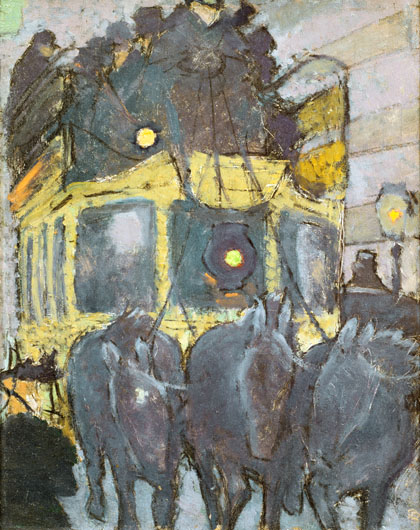Fr : version française / En: english version
mheu, Historical Museum of the Urban Environment
The Panthéon-Courcelles Omnibus
Pierre Bonnard

Date : 1890
Size : 26 x 35 cm
Technique : oil on board mounted on canvas
Location : collection privée
Photo credit: © DACS
View this work in the Urban transportation exhibition
The work
While preparing to enter art school, Bonnard did numerous sketches of scenes from Parisian life. In 1895, he drew the Panthéon-Courcelles Omnibus from life. At the time, this lumbering double-decker coach carrying 40 passengers and drawn by three horses was one of the busiest lines run by Compagnie Générale des Omnibus. Bonnard managed to capture its power thanks to a bold low viewing angle. This small oil on board, now at the Fondation Bemberg in Toulouse, in 1899 was used for the cover of the first edition of Georges Courteline's musical L'omnibus Panthéon-Courcelles which makes fun of the line's legendary slowness.
The artist
Pierre Bonnard, born in Fontenay-aux-Roses in 1867, was initially part of the Nabi group, along with Vuillard, Vallotton and Maurice Denis. He had met Vuillard at the Ecole des Beaux-Arts in Paris where he went in 1888 after obtaining a law degree. He was fond of Japanese art which gave him an unusual conception of space, with off-center arrangements, no perspective and rich decorative motifs.
He became a lawyer in 1890 and spent his time drawing his fellow lawyers in court. In 1893 he met Marthe, who became his model and companion. In the early 20th century he traveled, to Italy, Spain, Belgium and Holland. On his return, his art gradually moved away from the Nabi and his palette lightened. He painted a lot of nudes and developed a passionate interest in the play of light on the body.
When he met Monet in 1912, he tried his hand at landscapes but very quickly restricted the space to a garden, an interior or a bathroom, the intimate places where he could combine the play of light on the skin with decorative motifs - flowers, plants, tiles, drapes, etc. He retired to the south of France where he kept company with Matisse and died at Canet in 1947.